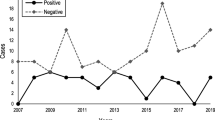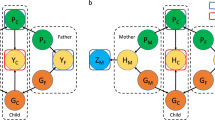Abstract
The majority of individuals at risk for Huntington disease (HD) is afraid to learn more precisely about their genetic status, as is suggested by the low uptake of the predictive test for HD. Subsequently, the future expectancies of individuals at risk are often based on rough risk estimates such as 50% (child of an affected individual) or 25% (grandchild). Individuals at risk can be offered a better risk estimate based on their current age, length of the disease causing CAG-repeat in the HD gene in close relatives, information on the age at onset, or test results of children. Regression modelling and Cox regression determined relations between ages at onset and CAG repeat length in a sample of 755 tested individuals. A model for calculating the adjusted residual risk status was constructed and implemented in a spreadsheet that can be used in genetic counselling. This model and accompanying spreadsheet broadens the information repertoire for genetic counsellors by providing an optimal estimation of the residual risk status.


Similar content being viewed by others
References
Kremer B. Clinical neurology of Huntington’s disease—diversity in unity, unity in diversity. In: Bates G, Harper PS, Jones L, editors. Huntington’s disease. 3rd ed. Oxford: Oxford University Press; 2002. p. 28–61.
American College of Medical Genetics, American Society of Human Genetics, Group HDGTW. Laboratory guidelines for Huntington disease genetic testing. Am J Hum Genet 1998;62.
Maat-Kievit A, Losekoot M, Zwinderman K, Vegter-van der Vlis M, Belfroid R, Lopez F, et al. Predictability of age at onset in Huntington disease in the Dutch population. Medicine 2002;81:251–9.
Brinkman RR, Mezei MM, Theilmann J, Almqvist E, Hayden MR. The likelihood of being affected with Huntington disease by a particular age, for a specific CAG repeat. Am J Hum Genet 1997;60:1202–10.
Wintrebert CM, Zwinderman AH, Maat-Kievit A, Roos RA, van Houwelingen HC. Assessing genetic effects in survival data by correlating martingale residuals with an application to age at onset of Huntington disease. Stat Med 2006;25:3190–2000.
Langbehn DR, Brinkman RR, Falush D, Paulsen JS, Hayden MR, International Huntington’s Disease Collaborative Group. A new model for prediction of the age of onset and penetrance for Huntington’s disease based on CAG length. Clin Genet 2004;65:267–77.
Harper PS, Newcombe RG. Age at onset and life table risks in genetic counseling for Huntington’s disease. J Med Genet 1992;29:239–42.
Farrer LA, Conneally PM. A genetic model for age at onset in Huntington disease. Am J Hum Genet 1985;37:350–7.
Krawczak M, Bockel B, Sandkuijl L, Thies U, Fenton I, Harper PS. Covariate-dependent age-at-onset distributions for Huntington disease. Am J Hum Genet 1991;49:735–45.
Ridley RM, Frith CD, Crow TJ, Conneally PM. Anticipation in Huntington’s disease is inherited through the male line but may originate in the female. J Med Genet 1988;25:589–95.
Roos RA, Vegter-van der Vlis M, Hermans J, Elshove HM, Moll AC, van de Kamp JJ, et al. Age at onset in Huntington’s disease: effect of line of inheritance and patient’s sex. J Med Genet 1991;28:515–9.
Bonke B, Tibben A, Lindhout D, Stijnen T. Favourable mutation test outcomes for individuals at risk for Huntington disease change the perspectives of first-degree relatives. Hum Genet 2002;111:297–8.
McCusker E, Richards F, Sillence D, Wilson M, Trent RJ. Huntington’s disease: neurological assessment of potential gene carriers presenting for predictive DNA testing. J Clin Neurosci 2000;7:38–41.
de Boo G, Tibben A, Hermans J, Maat A, Roos RA. Subtle involuntary movements are not reliable indicators of incipient Huntington’s disease. Mov Disord 1998;31:96–9.
Witjes-Ané MN, Vegter-van der Vlis M, van Vugt JP, Lanser JB, Hermans J, Zwinderman AH, et al. Cognitive and motor functioning in gene carriers for Huntington’s disease: a baseline study. J Neuropsychiatry Clin Neurosci 2003;15:7–16.
Harper PS, Gevers S, de Wert G, Creighton S, Bombard Y, Hayden MR. Genetic testing and Huntington’s disease: issues of employment. Lancet Neurol 2004;3:249–52.
Burgermeister J. Teacher was refused job because relatives have Huntington’s disease. BMJ 2003;327:827.
Quaid KA, Morris M. Reluctance to undergo predictive testing: the case of Huntington disease. Am J Med Genet 1993;45:41–5.
Burgess MM, Adam S, Bloch M, Hayden MR. Dilemmas of anonymous predictive testing for Huntington disease: privacy vs. optimal care. Am J Med Genet 1997;71:197–201.
Author information
Authors and Affiliations
Corresponding author
Electronic supplementary material
Below is the link to the electronic supplementary material.
Appendices
Appendices
Rights and permissions
About this article
Cite this article
Timman, R., Bonke, B., Stijnen, T. et al. Estimating decreased risks for Huntington disease without a test. Eur J Epidemiol 23, 281–287 (2008). https://doi.org/10.1007/s10654-008-9224-8
Received:
Accepted:
Published:
Issue Date:
DOI: https://doi.org/10.1007/s10654-008-9224-8




